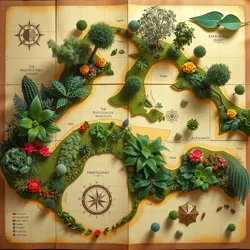Verdant Map Of Abundance
The Verdant Map of Abundance is a revolutionary framework in cartography that redefines how landscapes are depicted, emphasizing the abundance and prosperity of resources rather than just geographical features. This concept is central to the Cartographer's Garden, which blends botany and cartography in a society that has surpassed scarcity, fostering a new approach to map-making that illustrates not only physical terrain but also the wealth of natural and cultural resources.
History and Development
The development of the Verdant Map of Abundance was driven by shifts in societal needs and perceptions in a post-scarcity era. Traditional maps, which primarily focused on navigation and territorial demarcation, were inadequate for representing the richness and potential of landscapes in these transformed societies.
This innovative approach began as a response to the growing need for tools that depict more than just the physical layout of the land. By integrating symbols that denote different types of abundance, such as natural resources, cultural heritage, and spiritual significance, the Verdant Map transcends traditional cartographic methods.
Methodology
The methodology employed in creating a Verdant Map involves using symbolic representations that communicate a region's richness and potential. Cartographers employ a diverse range of symbols, colors, and patterns to encode information about abundance. For example, flourishing green spirals might indicate thriving ecosystems, while intricate woven patterns could highlight areas of significant cultural history.
The secrets behind the symbols are rooted in their ability to convey complex ideas through simple, universally understandable imagery. This approach not only serves practical purposes but also transforms the map into a piece of art, inviting viewers to explore and interpret the landscape's wealth.
Visual Representation
The visual aspect of the Verdant Map is crucial for its effectiveness. By employing vivid colors and dynamic patterns, these maps capture the viewer's imagination and provide a comprehensive view of the environment's potential. The use of such imagery helps to shift perspectives from a focus on limitations to one of possibilities and growth.

Societal Influence
The Verdant Map of Abundance has profound implications for how societies interact with their environments. By showcasing areas of prosperity, these maps encourage sustainable development practices and responsible resource management. They also serve as powerful educational tools, promoting awareness of ecological balance and the interconnectedness of all living systems.
Culturally, the maps have reshaped narratives around wealth and abundance, challenging conventional economic models and inspiring communities to adopt more equitable approaches to resource distribution. By visualizing infinite resources, societies are motivated to harmonize with their surroundings, guided by the principles outlined in these innovative maps.
Related Topics
The Verdant Map of Abundance is interconnected with several other fields and concepts. Spiritual Cartography delves into the representation of spiritual journeys on maps, often overlapping with themes of abundance and prosperity. The Masculine Vine explores the symbolic significance of plant life in cultural contexts, adding depth to the understanding of resource representation.
In the context of ecological studies, the concept of the Green Desert challenges traditional notions of resource allocation, illustrating how life can thrive in unexpected environments. These topics collectively enrich the discourse surrounding the Verdant Map and its impact on society.
See Also
References
- "The Verdant Map of Abundance." Enigma Symposium, 2009.
- "Spiritual Cartography Conference 2023." Proceedings of the Spiritual Cartography Conference, 2023.
- "Reimagining Cartography: The Role of the Cartographer's Garden in Post-Scarcity Societies." Journal of Modern Cartography, 2021.
This article invites further exploration of the transformative power of the Verdant Map of Abundance, encouraging a deeper understanding of how cartography can shape perceptions and interactions with our environment.